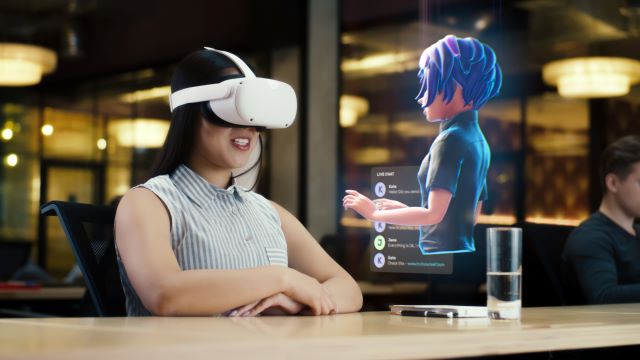
Arizona State University recently launched a volumetric capture lab, and, according to ASU News, the Hispanic-serving institution is one of the first in higher education to show what is possible when an audience can react to holograms in augmented reality (AR), virtual reality (VR), and 2D screens.
Located in ASU’s Thunderbird School of Management, the Thunderbird in-house studio, a 9-foot metal tower with 96 cameras, creates a 360-degree photo or video rendering to make an avatar that can be placed in an AR environment.
The process enables students around the world to advance from learning remotely to learning immersively in a three-dimensional space, with the assistance of a computer monitor or VR headsets.
Sanjeev Khagram, director general and dean of Thunderbird and the Foundation Professor of Global Leadership and Global Political Economy, told ASU News that the vision is to be the most global digital leadership and management school by harnessing key technological transformations of the Fourth Industrial Revolution.
In addition, Khagram said artificial intelligence (AI), Internet of Things (IoT), blockchain, and especially augmented reality (AR) and virtual reality (VR) has only accelerated since the onset of the pandemic.
Thunderbird art director Esly Diaz has used the technology several times to record himself. Here’s how he described the experience.
“When Dean Khagram suggested the plan to bring a volumetric capture lab to Thunderbird, I thought it was crazy, like something you’d see in the movies,” Diaz told ASU. “It reminded me of the time I saw an app on an iPhone. Everybody kept asking, ‘What’s an app?’ I feel like I’m back in that same timeframe. Everybody is now going to be asking, ‘What’s a volumetric scan?’ We’re now at that same point with this technology, and we think it’s going to change education forever.”
According to ASU News, while volumetric technology is redefining the entertainment industry, Thunderbird leadership is also planning for the lab to enable the school to educate more than 100 million learners by the start of the next decade.
“We’re shifting the paradigm of in-person and online education from the ‘sage on the stage’ or someone lecturing from a PowerPoint presentation and hoping a student, learner, professional can listen for two-and-a-half hours to something that is multi-dimensional, multimedia and engaging.”
Currently, Hollywood multimedia studios are building volumetric capture labs for feature films, documentaries, television series, TED Talks, AR apps, VR headsets, and future devices that have not been commercialized yet.
“This is a new pedagogy to do more collaboration. A 3D environment, we’ve found, is a more meaningful way to teach and reach our students,” Michael Grasso, director of digital initiatives, AV, and media for Thunderbird said. “The cameras pull terabytes of data down, compress the image, and piece one together, almost like a puzzle. We then upload it into the cloud so the video can be streamed to a phone. We’re the first higher education institution in the world to have something like this.”
Tomas Bilbao, Thunderbird’s executive director of branding and communications, said the lab is finding cutting-edge ways to enhance the experience for learners around the world.
“Leveraging all these technologies provides a completely different experience than the traditional in-classroom experience for our students, executive clients, and lifelong learners,” Bilbao said.
The U.S. Army Corps of Engineers has been tasked with…
Brown and Caldwell, a leading environmental engineering and construction firm,…
Humboldt State University, one of four campuses within the California…